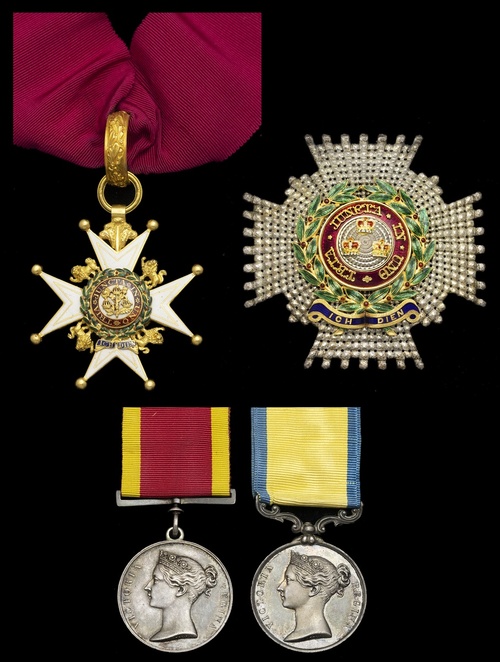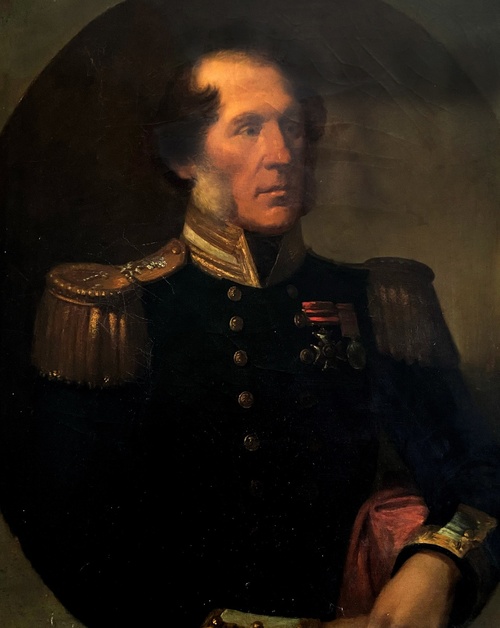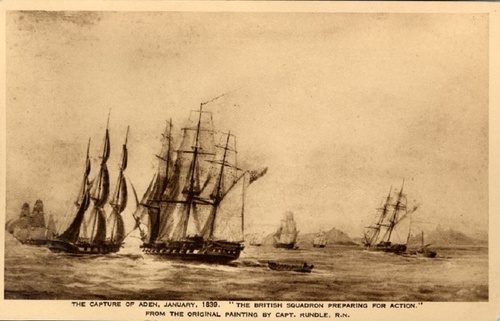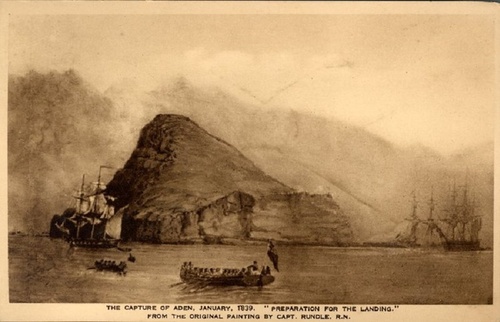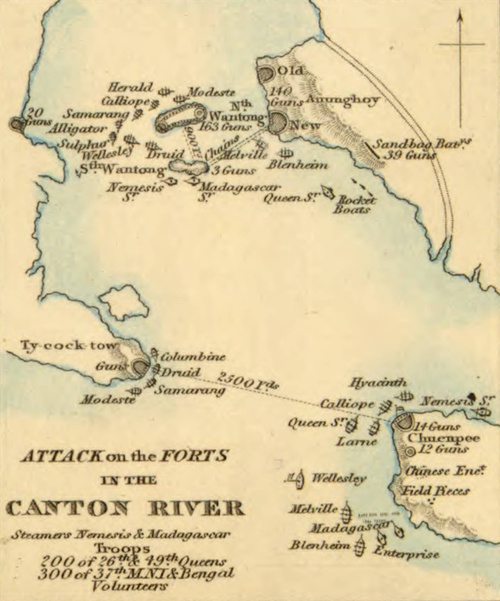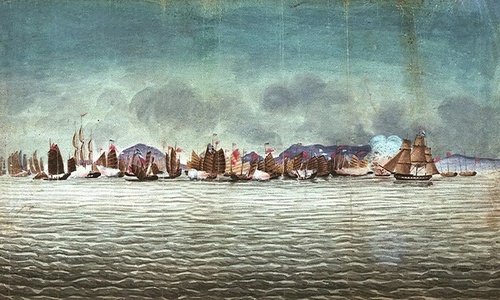Auction: 25001 - Orders, Decorations and Medals
Lot: 296
Sold by Order of a Direct Descendant
An outstanding 1873 K.C.B. group of three awarded to Admiral Sir H. Smith, Royal Navy - who was rewarded with a C.B. for his capture of Aden in 1839, the first colonial acquisition under the reign of Queen Victoria
Smith latterly played a prominent and central role during the First Opium War in the Volage and Druid; he took the honour of firing the first shots of the conflict and was to the fore in every major engagement
The Most Honourable Order of the Bath, Military Division, Knight Commander's (K.C.B.) set of Insignia, by R. & S. Garrard, London, comprising neck Badge, gold and enamel, hallmarks rather rubbed, with full neck riband and gold clasp; breast Star, gold centre, silver and enamel, gold retaining pin, reverse cartouche with maker's details, in slightly damaged case of issue; China 1842 (Henry Smith, Captain. H.M.S. Druid.), suspension replaced with dual loop, swivel and straight silver bar; Baltic 1854-55, unnamed as issued, good very fine (3)
K.C.B. London Gazette 24 May 1873.
[C.B.] London Gazette 13 August 1840.
Henry Smith was born circa 1803 and joined the Royal Navy at the tender age of eleven in 1814, being made a Lieutenant in July 1821. He joined the Genoa on the Lisbon Station in April 1823 and then as First Lieutenant to Captain Courtenay in the Fairy, who went out to the West Indies in May 1827. The following year, Smith took command of the brig Ferret, before advancing as Acting-Captain of the Magnificent in September 1829. It was in 1831 that he was officially promoted.
Aden - C.B.
Removed to Volage in November 1837, it was in this vessel that he first wrote his name into history. In January 1838, the Sultanate of Lahej agreed to transfer a number of its possessions, including the town of Aden to Britain but later decided against this and opened fire on the sloop-of-war H.C.S. Coote. Smith was given command of an expedition, comprising Volage, the brig Cruizer, Coote, the schooner H.C.S. Mahé and three transports to secure Aden. Smith and his small expedition arrived at Aden on 16 January 1839 and in the morning of 18 January Volage, Cruizer, and Mahé sailed to the front of the town from where they were fired upon.
At 0930hrs, the rest of the expedition arrived and the warships sailed in close to Aden's batteries to bombard them. By 1100hrs the gunnery of the ships had demolished Aden's lower batteries and destroyed a large tower, while landing parties ordered by Smith had cleared out the remaining enemy musket men in the rubble. At this point Smith ordered the main two landings of troops to take place, which were completed successfully with two naval casualties and sixteen from the army, with the defending garrison of 1,000 men suffering around fifty casualties. (The Royal Navy, a History from the Earliest Times to the Present William Clowes, refers).
So it was that Smith had captured the first Colonial acquisition for Great Britain and her new sovereign, Queen Victoria. He was rewarded with an immediate C.B. and the thanks of the George Eden, 1st Earl of Auckland, the Governor General of India.
Opium War - further firsts
The cataloguer turns to Clowes again for further details of these important events:
'Provocation and outrage continued; and when, on August 30th, Volage, 22, Captain Henry Smith, reached Macao, and at once proceeded to Hong Kong, her arrival was extremely welcome. On September 4th, the refusal of the Chinese at Kowloon to permit the transit of provisions across the harbour obliged Captain Smith, in concert with Mr. James Douglas (afterwards Sir James Douglas), of the Cambridge (the Cambridge was purchased by the Chinese government after regular hostilities began), formerly of the H.E.I. Co.'s marine, to employ his boats to drive off a squadron of war-junks, and so to open a passage for the supplies. Further outrageous action induced Elliot to call upon Smith to proclaim a blockade of the port of Canton as from September 11th.
Negotiations were subsequently entered into; but Elliot displayed such unwise weakness that the Chinese were only encouraged to persist in their implacable attitude. At length, the Hyacinth, 18, Commander William Warren, having joined the Volage, Elliot stiffened himself so far as to inform the Chinese, on October 28th, that if the British shipping lying below the Bogue were subjected to more of certain annoyances which had become intolerable, retaliatory measures would be adopted. The Chinese admiral, Kwan, returned first a temporising and then an insulting answer, and on November 3rd got under way with twenty-nine junks, evidently intending to attack. Smith made a further fruitless attempt to negotiate, and then, with the Volage and Hyacinth, opened fire, and in a short time won a success which would have been much more complete than it was, but for the interference of Elliot, who, when three junks had been sunk and as many more driven ashore, procured a cessation of the firing, alleging his desire to spare the lives of the Chinese. Kwan, on returning to Canton, was thus able to boast that he had been victorious; and he was rewarded accordingly.'
It had been on 4 September 1839 at around 1400hrs that Smith fired the first shots, sending several in anger in the direction of some war junks in the Chinese squadron.
On 30 June 1840 Smith was given command of another frigate, Druid (to which his Medal is named), in which he continued to blockade, taking eight merchant ships as prize by 10 July as Senior Naval Officer on the south of the Chinese coast. On 6 August, the missionary Vincent John Stanton was captured by the Chinese while swimming in Casilha Bay near Macao. Smith took a small avenge this, these being Druid, the sloops Larne and Hyacinth, and two smaller vessels. On 19 August Smith with 120 Royal Marines, 80 seamen, and 180 local volunteers, successfully fought the Battle of the Barrier in which he attacked the Chinese works and barracks at Portas do Cerco, including destroying seventeen guns and two junks; casualties were light, with four of the British wounded. By 1900hrs, the entire force had re-embarked on the ships and left the area ablaze, with so many cannonballs having been fired by the ships that they picked up their used shot to recycle it before leaving. It was said of Smith's actions at the battle that 'seldom has a more signal service been rendered in so short a space of time'. Druid continued after this to protect British trade and hunt down pirates, at one point having several men of a boarding party killed when the junk they were investigating blew up.
Smith was again to the fore at the Second Battle of Chuenpi on 8 January 1841. With joint attacks going in on the forts at Tycocktow and Chuenpi, guarding the entrance to Canton. Smith was to attack the former and having anchored some 200 yards off, they set to their work. The firing quickly created a breach in the fort which was attacked by boats manned by the crews of the ships and quickly taken. Twenty-five cannons were destroyed and the casualties of the Chinese were suggested to be 'very severe'. Smith was praised by Commodore Bremer for his conduct during the action. The opening to Canton was now complete.
During the Battle of the Bogue, on 25 February Smith took Druid in with a portion of Bremer's force to attack the Chinese batteries on the south, south-west, and north-west of the island of Wangtong, while also firing on the forts still active on the west bank of the river. The fire of the ships destroyed the batteries on Wangtong within the hour, allowing landing parties to attack and secure the location (Bulletins & State Affairs, refer).
The good Captain closed out the campaign at the Battle of Canton on 18 March and Battle of Amoy on 26 August, gaining further commendations for his good services and those of his vessel. He remained on the Station until 1843 and was rewarded with lavish gifts of silver from the local British community. He married the eldest daughter of Sylvester Costigin of Dublin, on 18 September 1844 in Berne, Switzerland, at the British Embassy.
Given command of Ganges at Sheerness in 1848, he saw brief service in the Baltic during the Åland War in command of the Prince Regent (Medal). He was promoted Rear-Admiral in July 1855 and later Superintendent of the Royal Hospital Haslar and the Royal Clarence Yard. Advanced to Vice-Admiral on 12 April 1862, Admiral in September 1865 and in November 1865 was rewarded with one of the two flag officer's good service pensions, worth £150 a year. Smith was advanced K.C.B. and retired in 1873 and died on 18 January 1887 at his home in Florence.
For his miniature dress medals, please see Lot 440.
Subject to 20% VAT on Buyer’s Premium. For more information please view Terms and Conditions for Buyers.
Estimate
£4,000 to £6,000
Starting price
£3000

